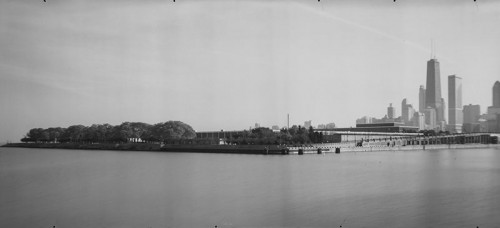
Last October, artists Lauren Bon, Tristan Duke and Richard Nielsen brought a giant shipping container to Chicago. That shipping container had been fashioned into a giant photography device, called a liminal camera, and the three artists drove it around the city in coordination with the annual Chicago Humanities Festival — quite literally exploring art through a new lens.
Almost seven months later, the culmination of Bon, Duke and Nielsen’s work is on display at the DePaul Art Museum. “Liminal Infrastructure,” a photography series depicting the city of Chicago as seen through the liminal camera, opened on May 14. The three rooms of the exhibit are designed to tell a story about Chicago’s history, infrastructure and recreation all in relevance to the water systems that have shaped the city over time.
The large banner-sized photos are mostly in black and white, and the subjects are all very recognizable to Chicago natives, from the Union Stock Yard Gate to the sandy beaches of Lake Michigan and so much more.
The exhibit is a collaboration between the Chicago Humanities Festival, the Metabolic Studio in Los Angeles and the team at the DePaul Art Museum.
The Metabolic Studio, home of the liminal camera project and many other artistic endeavors, was founded in 2005 by artist Lauren Bon, and the studio’s optics division and sonic division worked cooperatively to tell a geographical tale of the American West.
“I found myself particularly interested in how our city emerged and what our city’s relationship to the rest of the country was,” Bon said during a Chicago Humanities Festival discussion last October. This interest of hers sparked the larger liminal camera project, which aims to tell the story of various parts of America through its waterways and infrastructure.
Corrina Lesser, the Director of Programming and Planning for the Chicago Humanities Festival, first reached out to Greg Harris, the DePaul Art Museum exhibit’s curator, to discuss the potential for a residency and an exhibit over a year ago. Harris excitedly agreed.
“It sounded like a really interesting opportunity to join forces with the Humanities Festival, but also the work is really impressive and amazing work, and we’d never commissioned any new work before,” said Harris.
During the Chicago Humanities Festival in October 2014, Bon, Duke and Nielsen not only took the photographs on display, but they also allowed guests to come inside the camera and see what the photographing and developing processes were like for such a big device, and the negatives developed during that time were hung in the museum’s second-floor gallery for the public to observe.
“It is totally wild to be inside an enormous camera and to hear how the image is captured,” said Lesser via email. “The fact that the image is so huge — 12 feet by 8 feet — you don’t see prints that big very often.”
Harris emphasized that the photos selected displayed “Chicago as a hub of transportation, communication and trade, as that relates to the bodies of water around the city.”
The artists, and the liminal camera, returned to Chicago for the May 14 opening of the exhibit, and once again, the 250 guests present were given the opportunity to tour the camera. But this time, they got to see the final product: the banner-sized images displayed all around the first floor gallery of the DePaul Art Museum.
“It’s a really interesting approach to making photographs,” said Harris. “In a sense, it’s very basic and rudimentary in how they approach photography — they’re using the most basic technology that you can get your hands on and build yourself, but the scale is really impressive.”
“Liminal Infrastructure” runs through Aug. 9.

